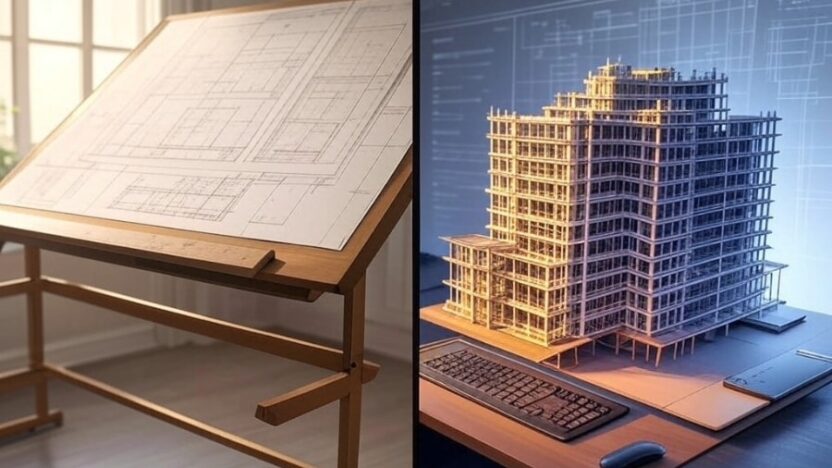The advent of AutoCAD in 1982 marked a revolutionary shift in the drafting and design industry, transforming how architectural drawings, engineering designs, and construction documents were created and managed. As one of the first significant computer-aided design (CAD) software tools tailored for personal computers, AutoCAD democratized design by allowing individuals to produce detailed and precise CAD drawings with unprecedented efficiency. Before this, drafting relied heavily on manual techniques involving T-squares, drafting boards, and other tools, which were both labor-intensive and prone to human error.
AutoCAD’s introduction brought about a profound transformation in design workflows. Architects, engineers, and CAD drafters could now develop more accurate drawings in a fraction of the time. With the added advantage of easy modifications and scalability, AutoCAD enabled designers to experiment with new products and ideas without restarting from scratch. The move from manual drafting to CAD design services also reduced physical storage requirements and streamlined the drafting process, setting the stage for further technological advancements in the AEC industry.
The 2D Mastery of AutoCAD
Core Capabilities and Industry Usage
AutoCAD’s powerful 2D drafting services quickly became a cornerstone for various industries, redefining precision, efficiency, and quality in design processes. It introduced revolutionary features like layers, line types, dimensions and weights that allowed for better organization and management of complex technical drawings.
- In Architecture: AutoCAD became an indispensable tool for creating highly detailed floor plans, elevations, and construction layouts. Its precision and flexibility allowed architects to visualize projects accurately and convey their ideas seamlessly to clients and construction teams.
- In Mechanical Engineering: AutoCAD enabled the meticulous design of parts and assemblies, ensuring that every component fit perfectly within larger systems. This drastically improved the efficiency of manufacturing processes and reduced costly errors.
Furthermore, the integration of AutoCAD with plotters streamlined the efficient production of physical drawings. Designers could easily print high-quality, professional-grade outputs directly from their digital designs, enhancing both workflow efficiency and client presentations.
Limitations and the Need for More
While AutoCAD’s 2D capabilities were groundbreaking, they came with inherent limitations. A flat, two-dimensional representation often struggled to capture the full essence of a design. Crucial aspects like depth, volume, and spatial relationships were left to the imagination, which could lead to misinterpretations or incomplete visualizations.
For example:
- Architects faced challenges in conveying how a building’s layout would feel in real life.
- Engineers found it difficult to anticipate how individual components would interact within a three-dimensional system.
This disconnect between what was drawn on paper and how it would exist in reality fueled the demand for more advanced solutions. The industry began to envision tools that could go beyond flat drawings, paving the way for the transformative era of 3D modeling.
The 3D Revolution in AutoCAD
Introducing 3D Modeling
As technology advanced, AutoCAD evolved to include groundbreaking 3D design features, revolutionizing the way designs were visualized and understood. These new capabilities transformed static drawings into dynamic, immersive models, offering designers unprecedented flexibility and control.
- Solid Modeling: This feature enabled the creation of accurate, realistic models that accounted for physical properties. Designers could analyze aspects like mass, density, and volume, ensuring that every detail met practical and functional requirements.
- Surface Modeling: Perfect for aesthetic and conceptual designs, surface modeling allowed for the creation of complex, smooth, and visually appealing shapes. It became an essential tool for industries focused on design aesthetics, such as automotive and product design.
With these tools, designers could now:
- Rotate models and explore them from any angle, providing a comprehensive understanding of design.
- Simulate real-world conditions, such as lighting and environmental effects, to assess how the model would appear and function in different settings.
💡 This shift to 3D modeling unlocked new possibilities, empowering professionals across industries to create design developing productss with greater depth, accuracy, and impact.
Enhancing Outcomes with 3D Modeling
- Architectural Applications: With 3D CAD modeling, architects can create immersive renderings and animations, enabling clients to experience a building before construction begins. Projects like the Marina Bay Sands in Singapore exemplify the power of advanced 3D tools in realizing ambitious designs.
- Manufacturing Benefits: In the manufacturing sector, AutoCAD’s 3D tools allow for precise prototyping and reverse engineering, reducing the need for physical iterations and accelerating the development process.
- Vendor Expertise on BuildTwin: BuildTwin vendors utilize AutoCAD’s 3D modeling features to craft detailed visualizations, aiding in logistics planning, material estimation, and stakeholder approvals.
How AutoCAD’s 3D Modeling Enhances Project Outcomes
Architectural Efficiency
AutoCAD’s 3D modeling has revolutionized architectural design by enabling the creation of detailed architectural plans that go beyond simple line drawings. A notable example is the Beijing National Stadium (Bird’s Nest), where advanced 3D modeling was crucial for visualizing and ensuring the design’s accuracy and structural integrity before construction began.
Manufacturing Advancements
In manufacturing, AutoCAD’s 3D capabilities have allowed for the precise design of complex parts and machinery, significantly reducing the need for physical prototypes. Companies and manufacturers like Siemens leverage 3D modeling in AutoCAD to design machinery components, allowing for simulations that show how parts interact, thus reducing potential assembly errors
BuildTwin’s Role in Advancing AutoCAD Services
Modern Tools and Vendor Expertise
At BuildTwin, we bridge the gap between project requirements and vendor expertise by connecting clients with pre-qualified vendors who specialize in AutoCAD design services and CAD drafting services. These vendors are proficient in the latest CAD software tools like AutoCAD, SolidWorks, and 3D modeling services, ensuring that each drafting process aligns with both industry standards and specific project demands. Their dual expertise in technical drawings and Building Information Modeling (BIM) guarantees that the final product of every design not only meets aesthetic expectations but also supports practical implementation and structural integrity.
Integration Beyond Drafting
BuildTwin goes beyond traditional drafting services by integrating AutoCAD into a broader ecosystem of project management:
Full Spectrum Services
Our service extends from the inception of a design concept through to detailed engineering and project execution. BuildTwin’s integrated ERP system encapsulates every step, making your project management not just about drafting but about achieving holistic project success.
Real-Time Project Tracking:
BuildTwin’s platform offers dynamic updates, enabling clients to track every phase of the CAD design project in real time. From concept development to the completion of detailed drawings, this feature ensures clients stay informed and can make adjustments promptly.
Tender Management:
The system simplifies the tendering process, allowing clients to manage design services with competitive pricing by inviting multiple bids from vetted vendors. This feature guarantees transparency and enables clients to choose the best fit for their project needs, be it architectural design, mechanical design, or product design services.
Direct Communication Channels:
Facilitate seamless communication between all project participants with integrated tools for instant messaging, document sharing, and collaborative feedback, eliminating the need for external communication platforms.
Global Marketplace
BuildTwin’s platform connects clients to a vast network of skilled CAD designers, offering expertise in 3D CAD, reverse engineering, and prototyping services. Whether your project involves mechanical engineering, furniture design, or the creation of technical drawings, our global marketplace ensures access to professionals with the precise skills required.
Benefits of 3D AutoCAD Services
1. Enhanced Project Visualization
Immersive Design Interaction
3D models offer a lifelike scale and interaction, allowing design company and stakeholders to engage with the design in a way that’s both intuitive and insightful. This visual clarity:
- Speeds Up Approvals: By providing a clear, detailed view of what the project will look like, decisions can be made more confidently and swiftly.
- Reduces Miscommunications: A visual representation minimizes the chance for misinterpretation, ensuring all parties have the same understanding.
2. Streamlined Design and Construction
Early Issue Detection
The ability to visualize in 3D helps identify potential issues like spatial conflicts or design clashes early on. This proactive approach:
- Minimizes On-Site Changes: Early detection means fewer surprises during construction, saving both time and money.
- Cuts Down Delays: By addressing conflicts before they impact the physical build, projects stay on schedule.
Outsourcing AutoCAD Drafting Services
Strategic Advantages of Outsourcing
- Cost Efficiency
Engaging with pre-qualified vendors listed on BuildTwin for CAD services allows firms to leverage global talent without the overhead of an in-house team. This approach can improve quality while effectively managing costs. - Flexibility
you can scale your project’s design needs. During high-demand periods, you can access additional AutoCAD expertise without committing to long-term employment. This provides the flexibility to align resources with project requirements.
BuildTwin’s Platform for Seamless Outsourcing
- Quality Assurance
The vendors on BuildTwin are vetted to ensure they meet high standards for AutoCAD services, providing confidence in the work delivered. - Compliance with Standards
The pre-qualified vendors on BuildTwin ensure all outsourced work adheres to international building codes and standards, maintaining project integrity and regulatory compliance. - User-Friendly Management
BuildTwin offers an intuitive platform where you can oversee projects, communicate with vendors, and monitor progress, all from one convenient location.
Conclusion
The path of AutoCAD from a 2D drafting tool to a comprehensive 3D modeling solution has reshaped how projects are conceived and executed in the AEC industry. BuildTwin’s vendors stands at the forefront of this evolution, offering not just advanced AutoCAD services but an ecosystem where these services integrate seamlessly into project management.
🚀 Collaborate with our pre-qualified vendors at BuildTwin for advanced AutoCAD Drafting Services.
Book your Demo with BuildTwin Success AdvisorFrequently Asked Questions
How do AutoCAD drafting services improve construction documentation?
AutoCAD drafting services produce detailed, standardized, and easily modifiable construction drawings that reduce errors, improve clarity, and facilitate coordination among project stakeholders, ultimately minimizing costly on-site changes.
What types of CAD drafting services are commonly offered?
CAD drafting services include architectural drafting, mechanical drafting, structural drafting, electrical drafting, and site civil design. These services cover everything from detailed floor plans and mechanical parts to electrical layouts and grading models.
What distinguishes CAD design services from basic drafting services?
CAD design services typically involve a broader scope, including conceptual design, 3D modeling, visualization, and integration with BIM workflows, whereas CAD drafting focuses more on creating accurate technical drawings and documentation.
How does BuildTwin facilitate access to expert AutoCAD drafting services?
BuildTwin connects clients with pre-qualified vendors specializing in AutoCAD drafting and CAD design services, ensuring quality, compliance, and seamless project management through an integrated platform for communication, tendering, and real-time tracking.



